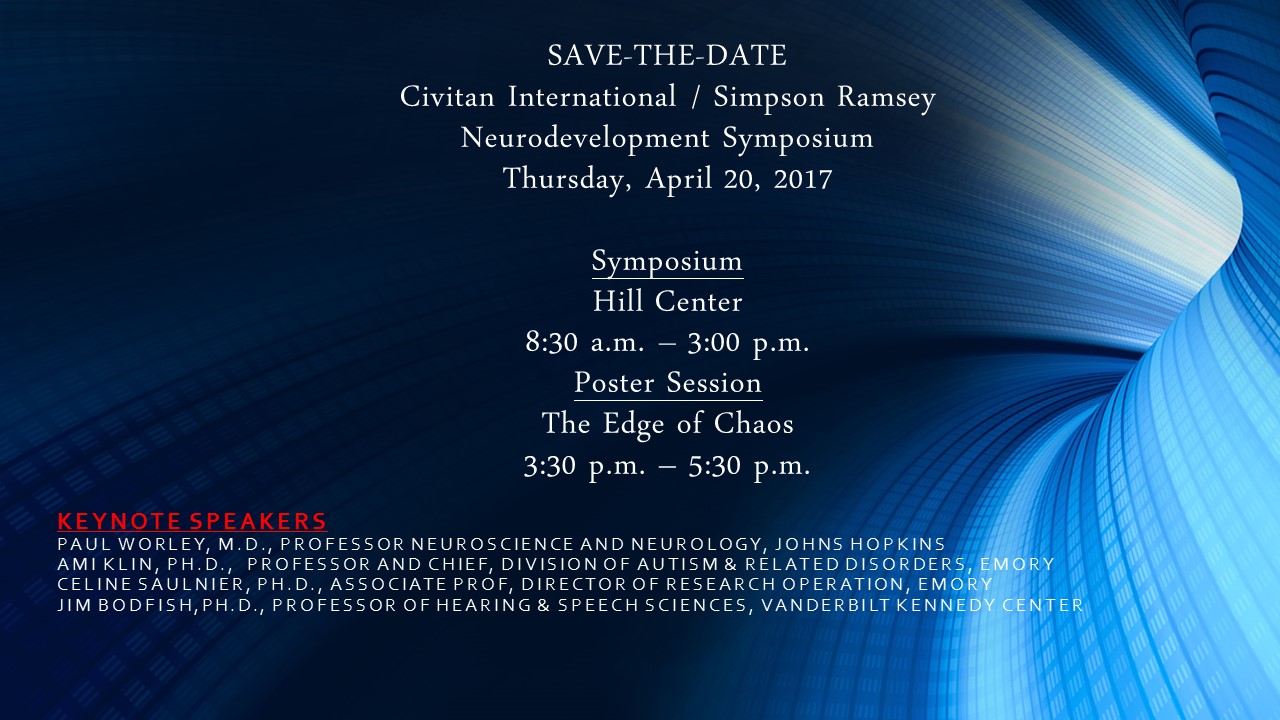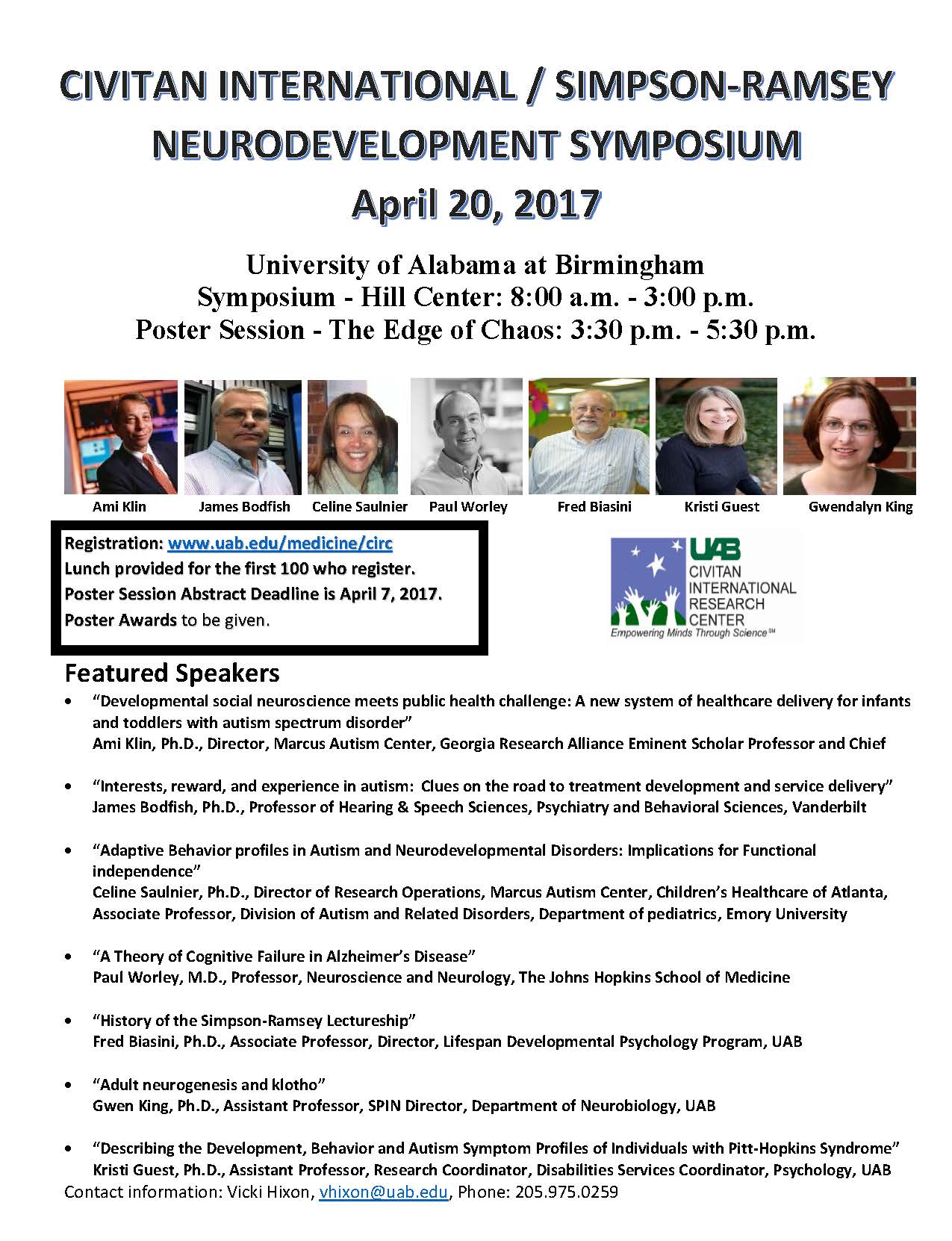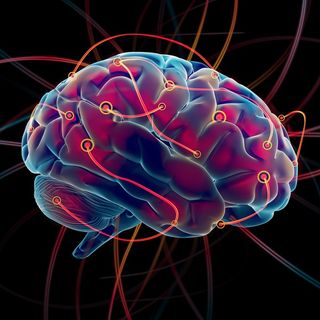Life-changing Research Being Conducted
Three UAB Students - Amgen Scholars Program
The highly-selective program provides fully-paid summer research opportunities for students at some of the country's premier institutions.
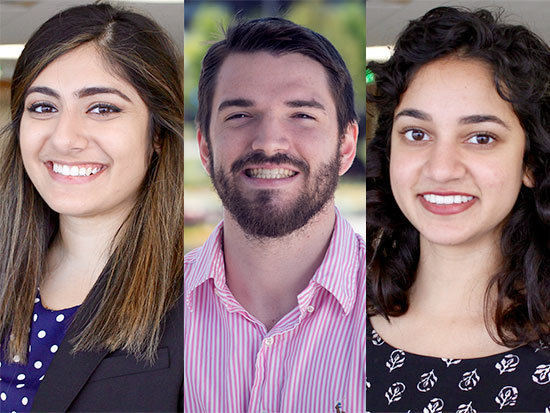 From left: Niharika Loomba, Cody Savage and Jasmin RevannaFor the fourth year in a row, students from the University of Alabama at Birmingham have been selected for the Amgen Scholars U.S. Program. This year, three students will take part in the highly selective program, which provides 200 undergraduates with fully paid summer research opportunities at 10 of the nation’s premier educational institutions.
From left: Niharika Loomba, Cody Savage and Jasmin RevannaFor the fourth year in a row, students from the University of Alabama at Birmingham have been selected for the Amgen Scholars U.S. Program. This year, three students will take part in the highly selective program, which provides 200 undergraduates with fully paid summer research opportunities at 10 of the nation’s premier educational institutions.The Amgen Scholars summer program is funded by a 12-year, $50 million commitment from the Amgen Foundation to support student research at world-class institutions. The program aims to increase student interest in pursuing advanced training and careers in the sciences.
Niharika Loomba, a neuroscience teaching assistant in the College of Arts and Sciences’ Department of Biology, will conduct research at Stanford University’s SSRP-Amgen Scholars Program. “Receiving this incredible opportunity has helped me take one step closer toward achieving my dream of becoming a neuroscientist,” Loomba said.
“During my time at Stanford, I hope to explore new areas of science,” Loomba said. “I am always eager to learn new things, so immersing myself in science for this nine-week program is really exciting.” Loomba says she is looking forward to networking with students and scientists from across the country and is appreciative of her mentors and peers at UAB who have helped her achieve this goal.
Jasmin Revanna, a neuroscience student studying epigenetic mechanisms at UAB’s Department of Neurobiology, says she was ecstatic when she received her acceptance into the Caltech Amgen Scholar Program.
“The project I proposed aims to create an animal model for autism spectrum disorder while utilizing the CRISPR/Cas9 genome editing tool,” Revanna said. “While at Caltech, I hope to gain experience working with nematodes, which is something I have never done, while making use of the lab techniques I already know.” She hopes this opportunity will open the door for bigger opportunities and ultimately increase her chances of acceptance into graduate school. Both Loomba and Revanna are students in the UAB Honors College.
Cody Savage says he is deeply honored to have been chosen to be an Amgen Scholar. Savage is a neuroscience major graduating in the fall with dreams of pursuing a career as a biomedical scientist. During his time as an undergrad, he had many research opportunities ranging from genetic studies to electron microscopy.
“I hope to gain knowledge of new experimental techniques, develop an interesting research project and soak up as much information as possible from the distinguished scientists at Washington University in St. Louis,” Savage said.
Focus on Alzheimer's disease shifts to prevention
April 11, 2017
- Advances in brain imaging allowing early detection of the plaques implicated in Alzheimer’s disease have pushed prevention strategies in the fight against dementia.
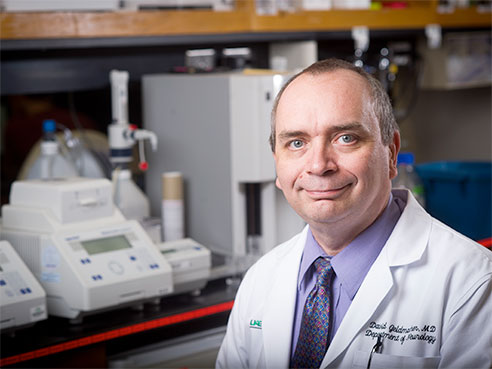 David Geldmacher, M.D., the Warren Family Endowed Chair in Neurology
David Geldmacher, M.D., the Warren Family Endowed Chair in Neurology
- It has been 111 years since Auguste D. became the first person described with what is now called Alzheimer’s disease. German psychiatrist Alois Alzheimer, for whom the disease is named, first publically reported his observations of Auguste in 1906, upon her death at age 56. Now, as life expectancy grows — there are 29 nations with an average life expectancy of 80 years of age or older — the specter of Alzheimer’s disease looms larger than ever.
- “In my experience, Alzheimer’s disease is the most feared disease in people over 65,” said David Geldmacher, M.D., the director of the
- in the
- at the
- . “And while it’s true that efforts to find a cure for AD have not yet proved successful, much of that fear may be misplaced, since we have learned so much about the disease in the last several decades.”
- So much so that Geldmacher says prevention, not cure, may be the key to stopping Alzheimer’s.
- “When I started my career treating dementia, Alzheimer’s was a black box that we couldn’t open,” he said. “We couldn’t even diagnose the disease except with an autopsy after death. We couldn’t treat it or slow its progression, or stop it in the first place. Today we have a much better understanding of Alzheimer’s and are much closer to developing meaningful therapies that will be beneficial in prevention and treatment.”
- Geldmacher, who was recently named the Warren Family Endowed Chair in Neurology in the UAB
- , likens the process to how medicine overcame earlier scourges such as pneumonia. “First we had to discover germ theory, then isolate the bacteria responsible for pneumonia, develop antibiotics to kill the bacteria and then ultimately develop a vaccine to prevent the disease in the first place,” he said. “That took about 100 years. We are following the same pathway of knowledge with Alzheimer’s, but now with much better tools.” One of those tools is the PET scan, or positive emission tomography. PET scans use radioactive tracers that can bind to substances in the body and then light up during the scan, producing images that show increased brain activity.
- In Alzheimer’s, advanced imaging facilities such as UAB use a special tracer that binds to a brain protein called amyloid beta. Amyloid is routinely produced in the brain, but an abnormal increase or buildup of amyloid is toxic, and a hallmark of Alzheimer’s.
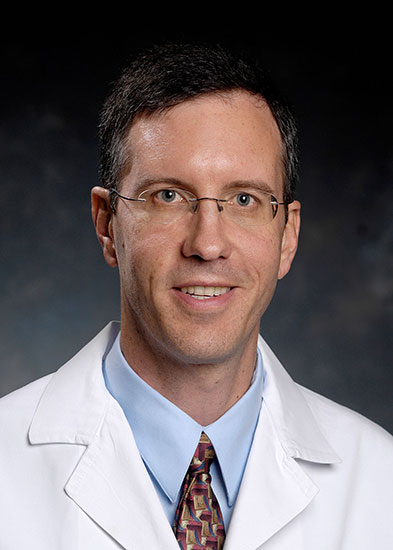 Erik Roberson, M.D., Ph.D., the Patsy W. and Charles A. Collat Professor of Neuroscience
Erik Roberson, M.D., Ph.D., the Patsy W. and Charles A. Collat Professor of Neuroscience
- “We can now use PET imaging to look at the brain of a person without any symptoms of memory loss or dementia, and see if a buildup of amyloid is already occurring,” Geldmacher said. “This doesn’t tell us when symptoms of dementia might start, but does indicate an increased risk for Alzheimer’s at some point in the future. More importantly, it gives us a target for aggressive efforts to reduce the amount of amyloid and hopefully reduce the risk.”
- UAB is actively involved in several clinical trials aimed at reducing amyloid levels in the brain, including the
- , a national trial with 66 investigational sites. Participants will undergo PET imaging to search for amyloid buildup. Those with significant amyloid will receive a drug called solanezemab, delivered via infusion, which binds to amyloid protein and helps the body dispose of it. A second trial, called
- and coming in 2017, is for an oral medication that is thought to inhibit the production of amyloid, reducing its level in the brain.
- The
- is looking at a version of early-onset Alzheimer’s called dominantly inherited Alzheimer’s disease, a more rare disease type caused by a genetic mutation. “This study, conducted in younger individuals who are at genetic risk of the disease because of a parent with Alzheimer’s due to one of these mutations, is testing two monoclonal antibodies designed to reduce amyloid,” said Erik Roberson, M.D., Ph.D., the Patsy W. and Charles A. Collat Professor of Neuroscience, and primary investigator at UAB for the trial. “While there are some differences between this type of early-onset disease and the more common age-associated disease, we believe the results will have implications for future studies and treatments for all types of Alzheimer’s.”
- Another trial, called
- , is a Phase III study assessing a drug called aducanumab for Alzheimer’s. Results of a prior study of aducanumab indicated that it had a dose response curve, meaning higher doses showed better responses. The EMERGE trial is recruiting patients with a condition referred to as mild cognitive impairment. “Now that we can use PET imaging to predict the likelihood of Alzheimer’s, we’ve changed how we characterize the disease,” Roberson said. “We used to consider mild cognitive impairment to be a precursor of Alzheimer’s. Now we look upon it as part of the disease, simply an early stage. For prevention strategies to work, we have to consider the first sign of amyloid buildup — before symptoms emerge — as the starting point of Alzheimer’s disease.”
- Even though Geldmacher and Roberson are excited about the prospects of prevention, both understand that better therapies for those who already have the disease are needed, as are better ways to help families and caregivers manage the complexity of coping with an Alzheimer’s patient. “We can’t reverse dementia once it has begun, and we can’t induce the body to make more neurons after brain cells are lost,” Roberson said. “We have to find ways to ease symptoms and provide a better quality of life.”
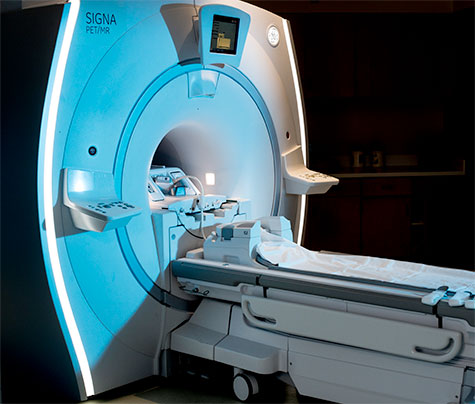 PET scans use radioactive tracers that can bind to substances in the body and then light up during the scan, producing images that show increased brain activity.
PET scans use radioactive tracers that can bind to substances in the body and then light up during the scan, producing images that show increased brain activity.
- One method is using an individual’s own genetic makeup to predict and determine which medications on the market will work best to manage an individual’s particular symptoms. The Memory Disorders Division is working closely with UAB’s Hugh Kaul Personalized Medicine Institute to utilize the power of precision medicine in this effort.
- A Department of Defense study, done in collaboration with Rita Jablonski-Jaudon, Ph.D., an associate professor in the UAB
- , is using telemedicine for personalized caregiver coaching on how to respond to disruptive behaviors, reducing caregiver stress and improving the home environment. The project, which may also have utility for patients with traumatic brain injury, uses face-to-face coaching via the internet.
- Geldmacher also directs the UAB
- , the first such clinical service in the nation. Patients receive a detailed, personalized risk assessment, which includes family history, a detailed memory history for the patient, cognitive testing and a baseline MRI scan. That information is incorporated into existing risk-predictor models, which have been validated by research studies that followed thousands of patients for as many as 20 years to produce an accurate risk assessment.
- “We focus on the reversible risk factors,” Geldmacher said. “So many people facing dementia focus on the irreversible risk factors, such as ‘I’m getting older’ or ‘my dad or mom had dementia.’ We can’t change those things, but we can change things like levels of physical activity and cholesterol counts and blood-pressure numbers.” He says the studies have shown that reducing one or more risk factors can have a significant effect on reducing one’s overall chances of developing Alzheimer’s disease.
- “I am more optimistic that we will find ways to prevent and treat Alzheimer’s disease now than when I started in the field,” Geldmacher said. “The Risk Clinic, pre-symptomatic diagnosis, imaging gains — all of these advances have given us new targets for investigation. During my career, we have sequenced the amyloid peptide, and we have discovered the genes that might modify and regulate it. Most importantly, we have developed an understanding of the factors underour control that we can use now to modify the risk for developing Alzheimer’s disease.”
- For more information on UAB clinical studies for Alzheimer’s disease, click
- . Research studies are supported in part by the
- .
Panel Discussion: From Eye to Mind
Wednesday, April 12 |7-8 pm
Free and open to the public; refreshments provided.
Neuroscientist Kristina Visscher, philosopher Marshall Abrams, and artist Jessica Angel gather to discuss how the human brain processes visual information from different perspectives. Discussing the flexibility of the human brain to manage visual perception, the panelists will explore triggers of perception in seeking to understand the truthfulness of sight.
Parpura to lead national association of neurochemists
Dr. Parpura is a professor in the Department of Neurobiology.
Lubin & Hildalgo go the extra mile for their students
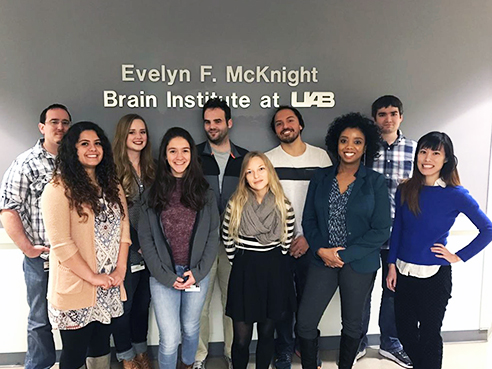 Farah Lubin, Ph.D., an associate professor of neurobiology at UAB, strives to make sure her mentees feel included, supported and encouraged.While earning her doctorate from Binghamton University, Farah Lubin had one specific goal: score a spot in the research lab of a respected professor who promised to take her on if she earned an A in his immunology class.
Farah Lubin, Ph.D., an associate professor of neurobiology at UAB, strives to make sure her mentees feel included, supported and encouraged.While earning her doctorate from Binghamton University, Farah Lubin had one specific goal: score a spot in the research lab of a respected professor who promised to take her on if she earned an A in his immunology class.After a semester of studying and “cranking out data” during rotations in his lab, she discovered that, while she earned an A in the lab component, she only earned a B+ in the lecture. Lubin said she was devastated — but not for long.
“The professor came to me and said that even if I’d gotten a D, my passion, grit and work ethic would have mattered more than my grade,” she said. He told her the grade she’d earned was one of the highest in the class, and asked her to be his teacher’s assistant for the course. “It took a lot of pressure off me. He was tough, but in the back of my mind, I knew he believed in me.”
Passing it on
Lubin, who has been mentoring formally since her days as a postdoc at Baylor College of Medicine in 2002, has had time to hone her craft. Now an associate professor of neurobiology at UAB, said she strives to be that kind of mentor for her students: honest and direct, while understanding that students learn and achieve in different ways.
| Twenty-four faculty will receive the Graduate Dean’s Excellent in Mentorship Award 2 p.m. April 6. |
Lubin is in a unique position to help young academics in her field as co-director of the UAB Neuroscience Roadmap Scholars Program, which provides a focused and individualized path for underrepresented and disabled students with an interest in graduate studies. She said the program gives students the best advantages, such as helping them learn approaches to budgeting, professionalism and networking.
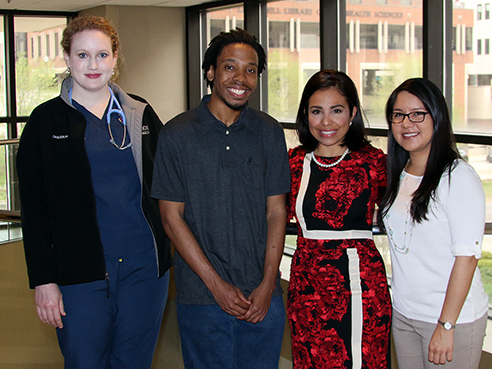 Bertha Hidalgo, M.D., assistant professor of epidemiology (second from right), with mentees (from left to right) Cindy Walden, MPH student in epidemiology; Calvin Colvin, undergraduate student in sociology; and Anarina Murrillo, postdoctoral fellow in UAB's Nutrition Obesity Research Center“If you don’t feel included or supported, especially in an environment where you don’t have people who look like you or you’re immediately labeled even before you speak, that adds a lot of pressure, even before you’re a grad student,” she said.
Bertha Hidalgo, M.D., assistant professor of epidemiology (second from right), with mentees (from left to right) Cindy Walden, MPH student in epidemiology; Calvin Colvin, undergraduate student in sociology; and Anarina Murrillo, postdoctoral fellow in UAB's Nutrition Obesity Research Center“If you don’t feel included or supported, especially in an environment where you don’t have people who look like you or you’re immediately labeled even before you speak, that adds a lot of pressure, even before you’re a grad student,” she said.For Will Webb, an MD/PhD student, getting Lubin as a mentor in 2014 was serendipitous. He’d already rotated in two labs when Lubin guest-lectured in one of his genetics courses, and he unexpectedly bumped into her in the elevator later that day. After talking about the lecture, he decided to throw caution to the wind and ask if she was recruiting graduate students for her lab; she was.
“She’s one of my first examples of learning how to be a mentor in a positive sense,” Webb said. “She is a much more experienced scientist than me, and though she often knows what my next experiment should be before I do, she will guide me Socratically and independently of her until I get to the same answer.”
He also said Lubin stays invested in the professional lives and long-term goals of the students she mentors.
“She asks about the big-picture stuff,” Webb said. “She keeps it on her radar and is always a willing ear for people who want to bounce ideas off of her or talk about future plans.”
Take part in Mentoring WeekFrom April 3-7, interested postdocs and faculty can learn more about being a mentor or finding one during Mentoring Week, with events like seminars and socials.April 3 Trainees and faculty can learn all they want to know about mentorship in the Mentoring Academy 9 a.m.-2 p.m. April 4 Explore the trainee/mentor relationship with Theatre Delta’s “Mentee/Mentor Pro-Action,” an interactive theatre group. Learn to improve communication, receive feedback, develop boundaries and more noon in The Edge of Chaos café. April 5 Trainees and faculty can eat barbecue, soak a professor in a dunking booth and check out posters displaying valuable campus resources 11 a.m.-1 p.m. in the Bevill Biomedical Research Building Courtyard. April 6 Listen to Dr. Jabbar Bennett, associate dean for diversity at Northwestern University, deliver a seminar on mentoring and diversity at noon, followed by the Graduate Dean’s Awards for Excellence in Mentoring presentation at 2 p.m. Both events are at The Edge of Chaos Café. April 7 Unwind from Mentoring Week with live music, food, drink and good company at Good People Brewing Company starting at 5 p.m. |
“There are aspects of great mentors I’ve had that I’ve incorporated into my style, like being present and checking in on people.” she said. “When I haven’t heard from someone in a month or so, I’ll be sure to send an email to check in. I’ll also set meetings in informal ways, like over a meal, and be sure to ask about aspects of their lives beyond the academics.”
Having Hidalgo as an informal mentor has proved invaluable for postdoc Anarina Murillo. She first met Hidalgo during her postdoctoral interview in 2016, after which Hidalgo invited her to the UAB Minority Health and Health Disparities Research Symposium and began introducing her to colleagues. Since then, Murillo said Hidalgo has offered her advice on ways to manage time, publishing, grant-writing and general aspects of her career.
We are both from Southern California and are Latinas, so I feel like I can connect and identify with her,” Murillo said. “She is a successful researcher with a strong record of publications, grant awards and mentoring. Plus, because she went through her postdoc studies at UAB, it’s very impactful for me to meet with her and hear about her experiences and how she navigated her career transitions.”
Hidalgo said she chooses to have informal mentees alongside her formal ones because she thinks it’s important to have influences in your life that aren’t necessarily tied to your academics.
When you’re coming up as a student in whatever profession on campus, it’s important to have mentors that aren’t just mentors on paper, but to whom you can go for perspectives without them having a professional stake in your success or grade,” she said.
One of Hidalgo’s previous mentees, Calvin Colvin, won first place in the Office of Undergraduate Research’s Summer Expo this past year for a project he worked on with Hidalgo. Now he is applying to graduate programs in epidemiology, she said, and it was his summer program experience that helped him make that choice.
I would say to potential mentors that you never know the impact you have,” Hidalgo said. “For that matter, it’s important to give one’s all as much as possible, because it can really change someone’s path and could provide a lot of inspiration to those seeking it.”
Civitan International / Simpson Ramsey Neurodevelopment Symposium
Diversity
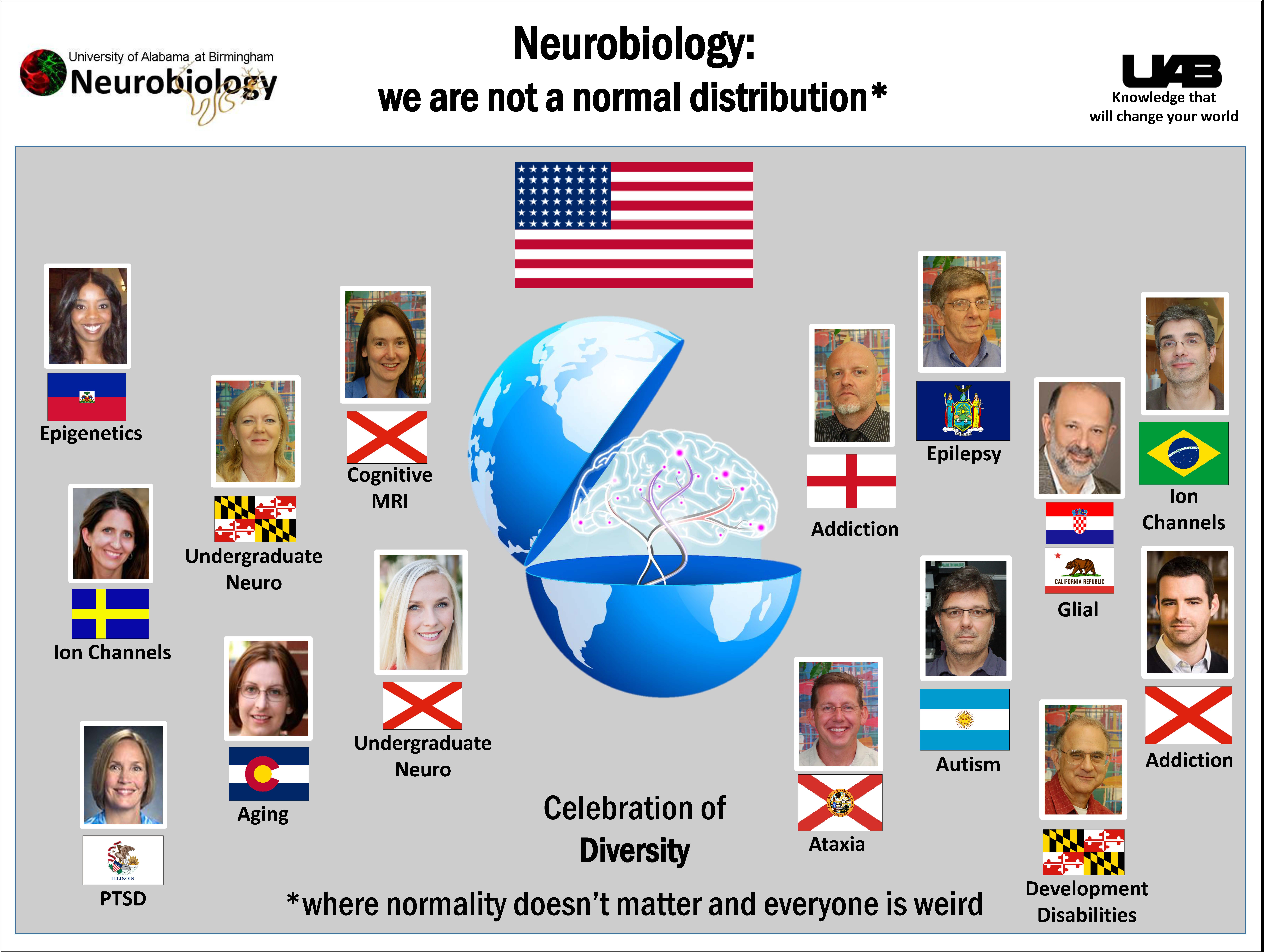
Dobrunz on ABC 33/40
ASD Training
by Adam Pope - February 17, 2017
- REACT is a unique public-private partnership created to align law enforcement and special needs communities to improve safety.

- A new educational program offered by the
- School of Health Professions, in conjunction with the
- , will train law enforcement to recognize and react to situations involving people with special needs.
- The
- , offered totally online, is open to all law enforcement serving across the United States.
- The online training is custom-designed specifically to be self-paced and learned without instructors present. A committee of UAB professors, working directly with experts from law enforcement and authorities in various areas of special needs, designed the curriculum to meet all standards of academic excellence.
 A committee of UAB professors, working directly with experts from law enforcement and authorities in various areas of special needs, designed the curriculum to meet all standards of academic excellence.
A committee of UAB professors, working directly with experts from law enforcement and authorities in various areas of special needs, designed the curriculum to meet all standards of academic excellence.
- “The responsibility of an academic institution to address societal needs, especially in their own community, is not an option — it is an obligation we take very seriously,” said
- ’ Dean Harold P. Jones, Ph.D. “This public-private partnership is a perfect example of our commitment to going beyond our obligation, because the REACT impact is such that it will not be felt solely in Birmingham, or only in Alabama. The online design means REACT has the potential to be felt in every community across the United States.”
- The REACT program, which had previously been taught only in a face-to-face format, evolved in response to incidents of law enforcement personnel mistaking certain behaviors from persons with autism or developmental disabilities as noncompliance or defiant behavior. The UAB-IAG partnership, recognizing the budget strains facing law enforcement across the nation, created the online format as an affordable solution accessible to everyone in an effort that would meet this growing societal need.
- Dustin Chandler, president and co-founder of IAG, is a former police officer and father of a daughter with special needs. He has witnessed both sides of this issue firsthand and sees the REACT program as a potentially lifesaving training solution for those with special needs and for law enforcement officers.
- “We understand first responders, parents and individuals with special needs all have the same priority — safety,” Chandler said. “We share that priority, and that is why our training emphasizes safety and provides officers with the information they need to safely interact with individuals with autism or a developmental disability.”
- According to the Autism Society, More than 3.5 million Americans are living with an autism spectrum disorder. When you consider a
- that says one in five adults in the United States has a disability, the need for the REACT training is real and immediate for law enforcement and the public they serve.”
- “Individuals with ASD are sometimes misunderstood and misperceived as being difficult or oppositional, particularly when involved in high-stress situations,” said Sarah O’Kelley, Ph.D., director,
- at
- and associate professor in the UAB
- . “Understanding that individuals with ASD may have different social skills and responses is extremely important for the community, including law enforcement officers.
| "Because symptoms of ASD are not always obvious during these encounters, it is important that law enforcement officers appreciate that there are multiple ways to view a person’s behavior and to respond with that in mind." |
- “Because symptoms of ASD are not always obvious during these encounters, it is important that law enforcement officers appreciate that there are multiple ways to view a person’s behavior and to respond with that in mind. Programs like REACT share a vision with a number of ASD-focused initiatives to increase the understanding of the ways that people are different from one another instead of focusing on what is ‘wrong’ or ‘right’ behavior in different situations.” “The question,” said Brian Hale, officer, Hoover Police Department, “is not if we will ever be on a call with an autistic person, but when. The REACT training is a must for all sworn law enforcement. As a former police officer, Dustin has a unique perspective and is able to relay the information in a way that all law enforcement and first responders can relate to and understand.”
- The REACT training involves real-world scenarios designed to deliver information to law enforcement in a way that is most retainable. Used in conjunction with in-person trainings, this is the best way to ensure the safety of the law enforcement community as well as the community each department serves.
- REACT, which has been endorsed by the
- , is a unique public-private partnership that launched with face-to-face training. In an initial rollout in 2016, more than 700 law enforcement officers were trained in person throughout Alabama. In 2017, the UAB-IAG partnership will increase the number of law enforcement officers reached exponentially as development of the affordable asynchronous online program means training is now available to all communities across the United States.
- .
Research Hodgepodge
Diversity of Thought

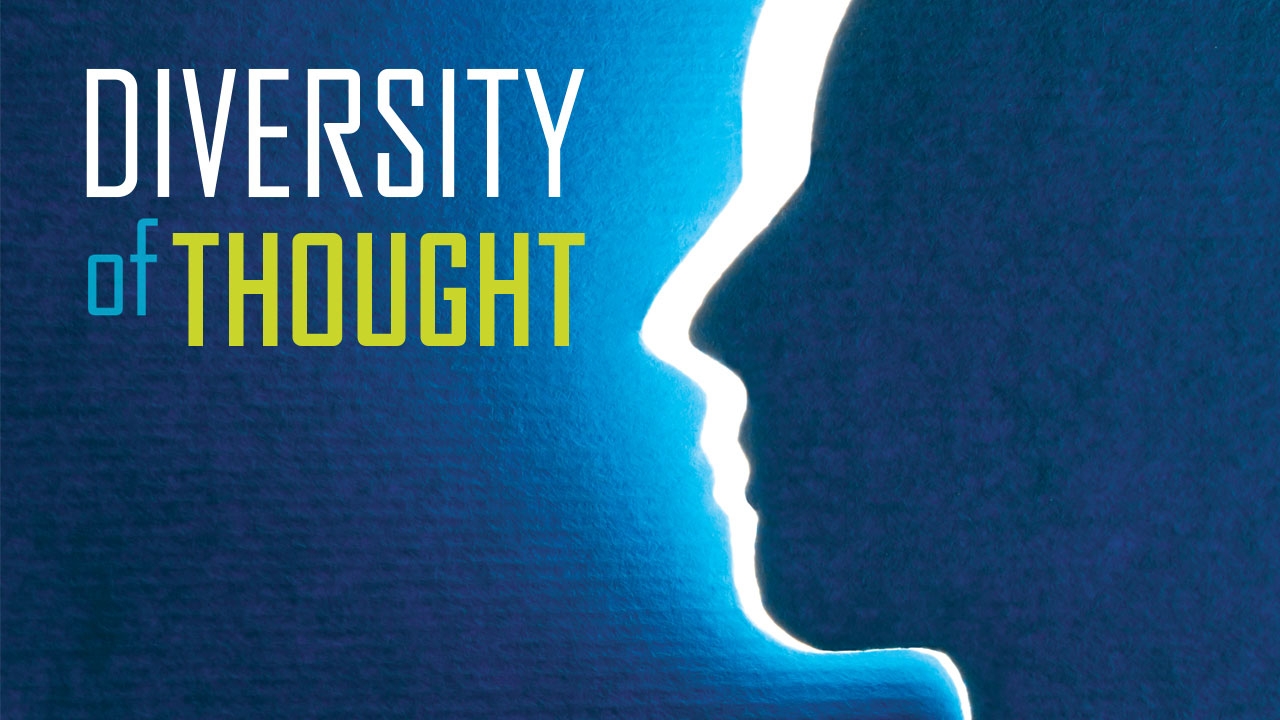 Neuroscience trainees navigate challenges beyond the lab
Neuroscience trainees navigate challenges beyond the lab
By Nancy Mann Jackson • Photos by Steve Wood
Even though she possessed a bachelor’s degree in chemistry and a master’s in biotechnology, Lillian Brady felt that she didn’t fit into the booming field of neuroscience. “As an underrepresented student, it can be easy to get into the mind frame that you don’t belong,” says Brady, a graduate of Alcorn State University, a historically black university in southwest Mississippi.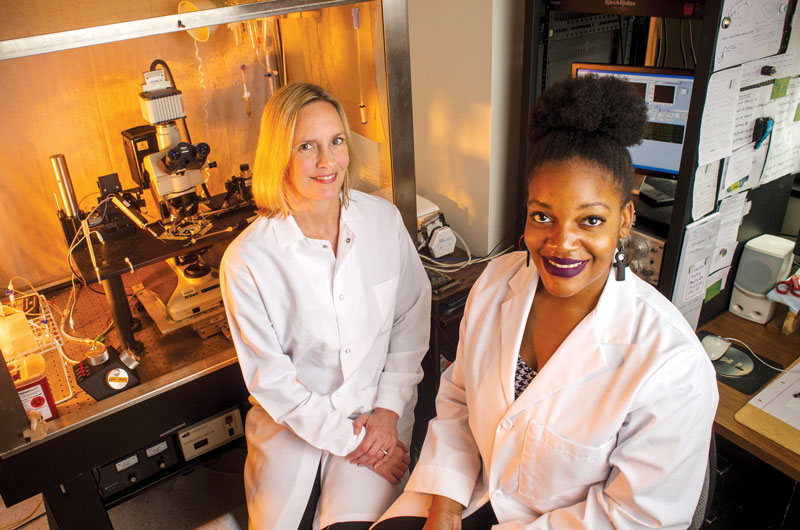 Each Roadmap Scholar works closely with a research mentor. Here, scholar Lillian Brady (right) meets with neurobiology associate professor Lynn Dobrunz.
Each Roadmap Scholar works closely with a research mentor. Here, scholar Lillian Brady (right) meets with neurobiology associate professor Lynn Dobrunz.
But then the Jackson, Mississippi, native found a place where she fit in perfectly: UAB’s Neuroscience Roadmap Scholars program, which is designed to help engage and retain underrepresented graduate trainees—including ethnic minorities and students with disabilities—in the neuroscience workforce.
Brady, now a doctoral student in UAB’s Department of Neurobiology, calls the program a “confidence booster” that has provided both support and encouragement. “I’ve been exposed to scientists who look like me and who have had some of the same challenges I am facing now,” she says. “These scientists are thriving in their fields, so I have no doubt that I can be successful in whatever career path I choose.”
Strengthening the Pipeline
“Through our experience working with students, we realized the pipeline for diverse neuroscientists was leaky,” recalls Farah Lubin, Ph.D., associate professor of neurobiology. “We might start with many diverse, motivated students, but somehow, many of them don’t make it into successful careers.”The problem isn’t talent or academic strength; rather, many students from diverse backgrounds or with disabilities may struggle with financial challenges, family needs, or a lack of confidence. Lubin and Lori McMahon, Ph.D., UAB Graduate School dean and UAB Comprehensive Neuroscience Center director, have seen such roadblocks dismantle the plans and goals of numerous students and coworkers.
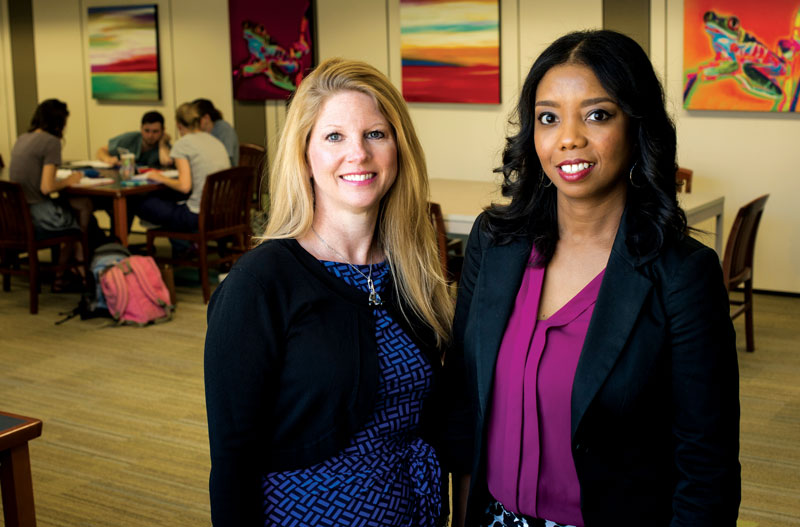 Roadmap co-directors Lori McMahon (left) and Farah Lubin (right) serve as career coaches for scholars outside the lab.
Roadmap co-directors Lori McMahon (left) and Farah Lubin (right) serve as career coaches for scholars outside the lab.To plug the pipeline’s holes, Lubin and McMahon developed Roadmap Scholars to emphasize mentoring, support networks, team-building experiences, and a community of peers to help guide more students to achieve neuroscience careers. Funded by a grant from the National Institute of Neurological Disorders and Stroke, the program launched in 2014. Today it includes 25 doctoral students.
The funding does not pay tuition or stipends; instead, it enhances and provides educational experiences to prepare students for further study and to encourage them to remain in neuroscience. And it works in tandem with the students’ graduate curriculum. For example, every Roadmap Scholar matches with a “career coach” in addition to a primary research mentor. The coach is a faculty member not on the student’s thesis committee who is available to talk about nearly anything—scientific projects, publishing and presenting, conflict management, or life in general, Lubin says. In doing so, these coaches provide additional professional perspectives and serve as an additional layer of support.
For Leland Fleming, a Fort Worth, Texas, native and UAB Graduate Biomedical Sciences doctoral student, the program’s peer and faculty network has made his goal of becoming a neuroscientist more tangible. “With its guidance and inspiration, it has made a once seemingly impossible goal something that I feel more than capable of accomplishing,” he says.
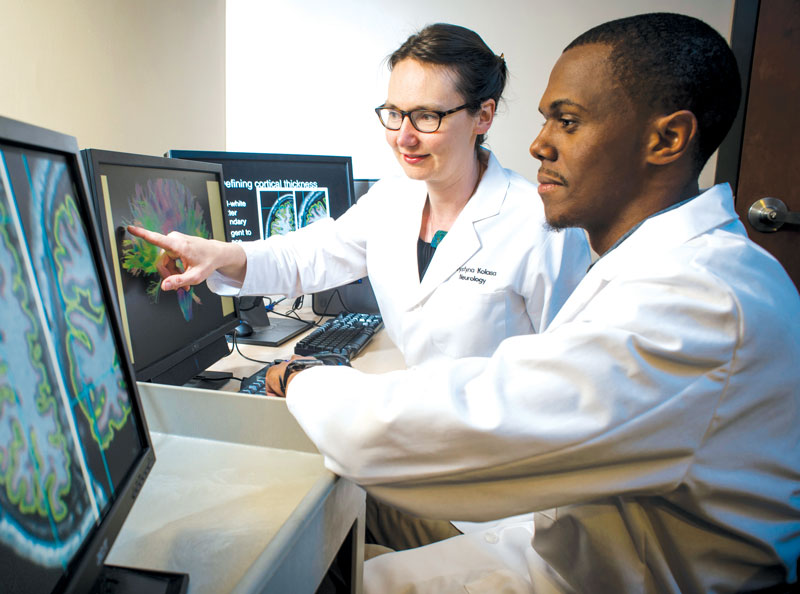 Leland Fleming (right) with his research mentor, neurobiology assistant professor Kristina Visscher
Leland Fleming (right) with his research mentor, neurobiology assistant professor Kristina VisscherCreating a Community
The support system kicks into gear even before the scholars’ first semester at the program’s summer NEURAL (National Enhancement of Underrepresented Academic Leaders) Conference, which draws neuroscience trainees from across the country. There, students can hone their networking and public speaking skills and interact with the field’s academic leaders. For instance, at the 2015 inaugural conference, leading neuroscientist Roger Nicoll, M.D., of the University of California San Francisco drew an emotional response from the audience when he spoke of succeeding despite his lifelong struggle with dyslexia.For Fleming, key conference takeaways included insights on common challenges that minority students can face in graduate school. These might be “feelings of inadequacy or feelings that he or she is merely an impostor on the brink of being exposed at any given moment,” he explains. But he and other students also received “terrific advice on coping with these issues when they arise,” Fleming says.
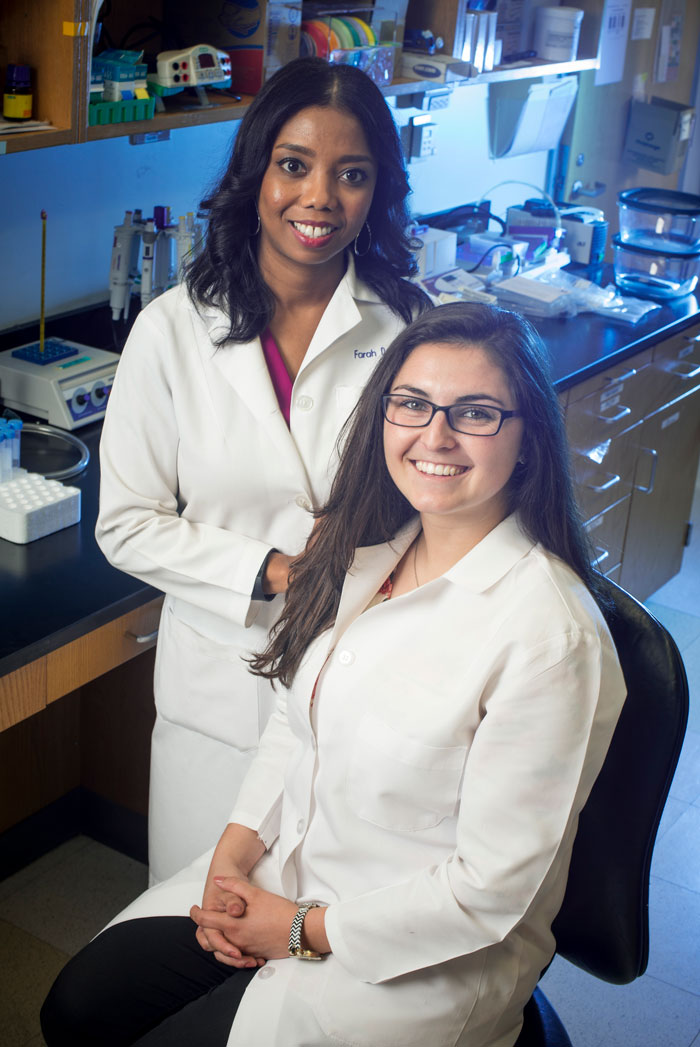 Lubin serves as a research mentor for scholar Rylie Hightower (right).
Lubin serves as a research mentor for scholar Rylie Hightower (right).The conference also helps to build strong bonds among students. Matthew Timberlake, a second-year graduate student who grew up in Fort Worth and Enterprise, Alabama, has enjoyed helping his colleagues to design and present lectures—even sharing his own research data with them. “I like the sense of community,” he says. “My colleagues and I—especially the upperclassmen—have an important role in discussions,” he says. “We help to ease some of the unknown for the underclassmen. In the same way, I also benefit from the upperclassmen’s advice and guidance.”
Rylie Hightower, an Albuquerque native who came to UAB after earning a nursing degree in New Mexico, is one of the newer students benefiting from those discussions. At a Roadmap spring retreat, Hightower sought advice from older students. Those interactions “will help me throughout my time at UAB and beyond,” she says.
The program has “made me feel at home away from home,” Hightower says. “But it also has helped me understand that a supportive community can greatly contribute to the way I think and perform as a student and as a scientist.”
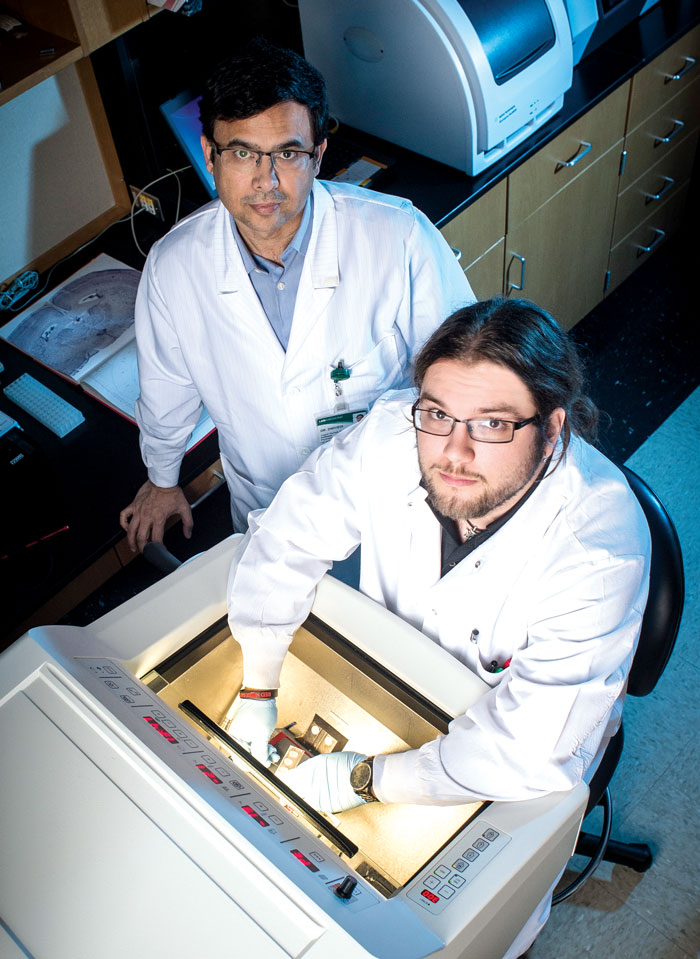 Matthew Timberlake (right) works with research mentor and psychiatry professor Yogesh Dwivedi.
Matthew Timberlake (right) works with research mentor and psychiatry professor Yogesh Dwivedi.The Road Ahead
Career planning is a key component of the program. Brady, who plans to obtain a postdoctoral position following her UAB training, found Roadmap’s “postdoctoral school” to be extremely valuable. She describes it as a weeklong crash course for senior graduate students covering “everything we need to know about postdoctoral positions. Not only were we given pointers on securing the right postdoc for our interest, but we also were exposed to postdocs in fields we might not have considered.”Every student also learns about neuroscience-related job opportunities in business and industry. “Often, students are encouraged to build a career path focused on remaining in academia,” says Megan Rich, a Fairfield, Connecticut, native and UAB Graduate Biomedical Sciences student. “The program has been great about expressing other options after graduate school and that it is OK to think about them.”
By helping these students to feel empowered, capable, and supported, the Neuroscience Roadmap Scholars program will lay the groundwork for future progress in one of the fastest growing scientific fields, McMahon says. Lubin agrees, noting that diversity is crucial for continuing advancements: “Diverse groups can offer unique perspectives and unique ideas, which will push the field forward.”
• Learn more about the Neuroscience Roadmap Scholars Program, including how to apply.
• Give something and change everything for the next generation of neuroscientists by supporting the School of Medicine.
McKnight Poster Reception
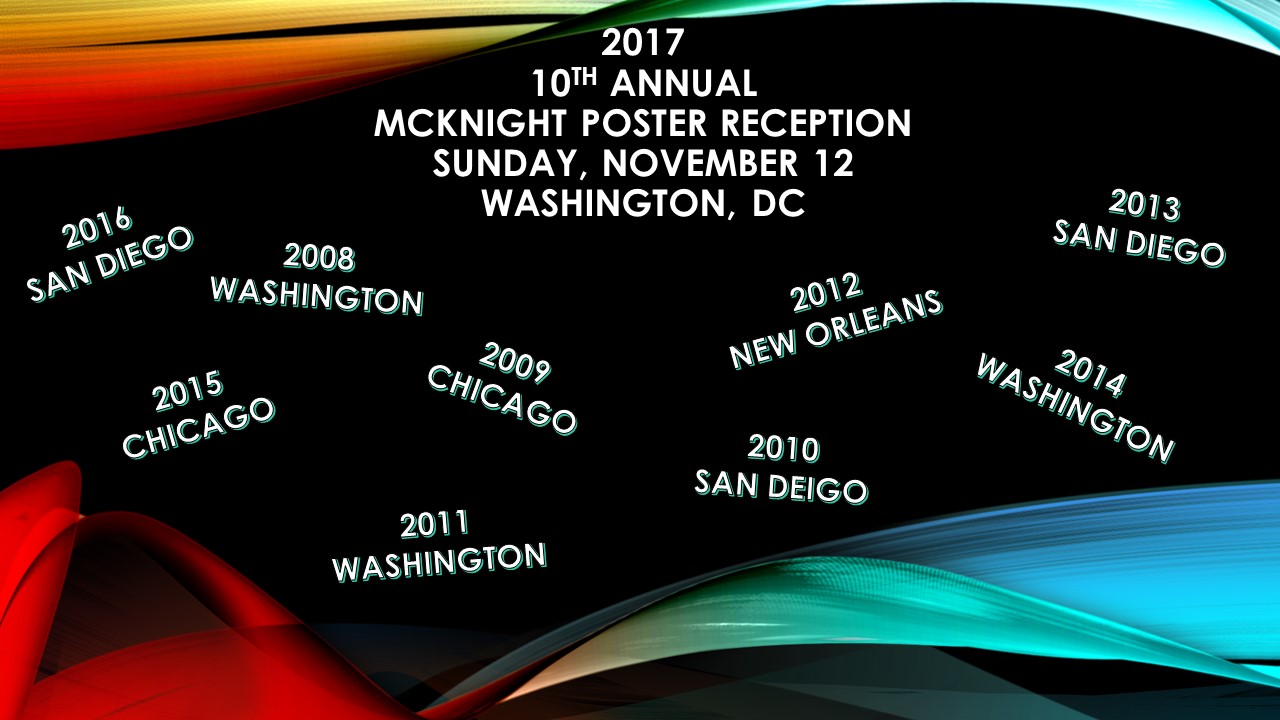
How do neuroplasticity and neurogenesis rewire your brain?
New research identifies how the birth of new neurons can reshape the brain.
Posted Feb 06, 2017
Neurogenesis and Neuroplasticity Work Together to Rewire Neural Circuitry
One of the key aspects of neural plasticity is called Neural Darwinism, or "neural pruning," which means that any neuron that isn’t ‘fired-and-wired’ together into a network is likely to be extinguished. The latest UAB research suggests that newborn neurons play a role in expediting this process by "winning out" in a survival of the fittest type of neuronal battle against their more elderly or worn out counterparts.Long before there were neuroscientific studies on neuroplasticity and neurogenesis, Henry David Thoreau unwittingly described the process of how the paths that one's mind travels can become hardwired (when you get stuck in a rut) by describing a well-worn path through the woods. In Walden, Thoreau writes,
"The surface of the earth is soft and impressible by the feet of men; and so with the paths which the mind travels. How worn and dusty, then, must be the highways of the world, how deep the ruts of tradition and conformity!"From a psychological standpoint, the latest UAB discovery presents the exciting possibility that when adult-born neurons weave into existing neural networks that new memories are created and older memories may be modified.
Through neurogenesis and neuroplasticity, it may be possible to carve out a fresh and unworn path for your thoughts to travel upon. One could speculate that this process opens up the possibility to reinvent yourself and move away from the status quo or to overcome past traumatic events that evoke anxiety and stress. Hardwired fear-based memories often lead to avoidance behaviors that can hold you back from living your life to the fullest.
Future Research on Neurogenesis Could Lead to New PTSD Treatments
Granule cells in the dentate gyrus are part of a neural circuit that processes sensory and spatial input from other areas of the brain. By integrating sensory and spatial information, the dentate gyrus has the ability to generate unique and detailed memories of an experience.Before this study, Overstreet-Wadiche and her UAB colleagues had a few basic questions about how the newly born granule cells in the dentate gyrus function. They asked themselves two specific questions:
Through a series of complex experiments with mice, Overstreet-Wadiche et al. found that some of the cortical neurons in the cerebral cortex transferred all of their former connections with older granule cells (that may have been worn out or past their prime) to the freshly born granule cells that were raring to go.
- Since the number of neurons in the dentate gyrus increases by neurogenesis while the number of neurons in the cortex remains the same, does the brain create additional synapses from the cortical neurons to the new granule cells?
- Or do some cortical neurons transfer their connections from mature granule cells to the new granule cells?
This revolutionary discovery opens the door to examine how the redistribution of synapses between old and new neurons helps the dentate gyrus stay up to date by forming new connections.
One of the key questions the researchers want to dive deeper into during upcoming experiments is: “How does this redistribution relate to the beneficial effects of exercise, which is a natural way to increase neurogenesis?”
In the future, it's possible that cutting-edge research on neurogenesis and neuroplasticity could lead to finely-tuned neurobiological treatments for ailments such as post-traumatic stress disorder (PTSD) and dementia. In a statement to UAB (link is external), Overstreet-Wadiche said,
"Over the last 10 years there has been evidence supporting a redistribution of synapses between old and new neurons, possibly by a competitive process that the new cells tend to 'win.’ Our findings are important because they directly demonstrate that, in order for new cells to win connections, the old cells lose connections.
So, the process of adult neurogenesis not only adds new cells to the network, it promotes plasticity of the existing network. It will be interesting to explore how neurogenesis-induced plasticity contributes to the function of this brain region.
Neurogenesis is typically associated with improved acquisition of new information, but some studies have also suggested that neurogenesis promotes 'forgetting' of existing memories."
Aerobic Exercise Is the Most Effective Way to Stimulate Neurogenesis and Create Adult-Born Neurons
For the past 10 years, the actionable advice I've given in The Athlete's Way has been rooted in the belief that through the daily process of working out anyone can stimulate neurogenesis and optimize his or her mindset and outlook on life via neuroplasticity."The Athlete's Way" program is designed to reshape neural networks and optimize your mindset. Since the beginning, this program has been based on the discovery that aerobic activity produces brain-derived neurotrophic factor (BDNF) and stimulates the birth of new neurons through neurogenesis. I describe my philosophy in the Introduction to The Athlete's Way,
"Shifting the focus from thinner thighs to stronger minds makes this exercise book unique. The Athlete's Way does not focus just on sculpting six-pack abs or molding buns of steel. We are more interested in bulking up your neurons and reshaping your synapses to create an optimistic, resilient, and determined mindset. The goal is transformation from the inside out.I created The Athlete's Way along with the indispensable help of my late father, Richard Bergland, who was a visionary neuroscientist, neurosurgeon, and author of The Fabric of Mind (Viking).
My mission is to get this message to you so that you can use neurobiology and behavioral models to help improve your life through exercise. I am a zealot about the power of sweat to transform people’s lives by transforming their minds. My conviction is strong and authentic because I have lived it."
A decade ago, when I published The Athlete’s Way: Sweat and the Biology of Bliss (link is external) (St. Martin's Press) I put neurogenesis and neuroplasticity in the spotlight. At the time, the discovery of neurogenesis was brand new, and still a radical notion in mainstream neuroscience.
In the early 21st century, most experts still believed that human beings were born with all the neurons they would have for their entire lifespan. If anything, it was believed that people could only lose neurons or "kill brain cells" as we got older.
Understandably, when I published The Athlete's Way in 2007 there were lots of skeptics and naysayers who thought my ideas about reshaping mindset using a combination of neurogenesis and neuroplasticity through moderate to vigorous physical activity were ludicrous.
For the past 10 years, I've kept my antennae up and my finger on the pulse of all the latest research on neurogenesis and neuroplasticity hoping to find additional empirical evidence that gives more scientific credibility to my system of belief and The Athlete’s Way methodology.
Needless to say, I was over the moon and ecstatic this morning when I read about the new research by Linda Overstreet-Wadiche and Jacques Wadiche that pinpoints the specifics of how adult-born neurons modify existing neural circuits. This is fascinating stuff!
These are exciting times in neuroscience. Modern day neuroscientific techniques are poised to solve many more riddles regarding the complex mechanism by which neurogenesis and neuroplasticity work together as a dynamic duo to reshape our neural networks and functional connectivity between brain regions. Stay tuned for future empirical evidence and scientific research on neurogenesis and neuroplasticity in the months and years ahead.
In the meantime, if you'd like to read a free excerpt from The Athlete’s Way that provides some simple actionable advice and practical ways for you to stimulate neurogenesis and rewire your brain via neuroplasticity and moderate to vigorous physical activity—check out these pages from a section of my book titled: "Neuroplasticity and Neurogenesis: Combining Neuroscience and Sport (link is external)."
References
Elena W Adlaf, Ryan J Vaden, Anastasia J Niver, Allison F Manuel, Vincent C Onyilo, Matheus T Araujo, Cristina V Dieni, Hai T Vo, Gwendalyn D King, Jacques I Wadiche, Linda Overstreet-Wadiche. Adult-born neurons modify excitatory synaptic transmission to existing neurons. eLife, 2017; 6 DOI: 10.7554/eLife.19886 (link is external)
Summer Neuroscience Program
UAB summer neuroscience program expands with NSF funding
by Bob Shepard - February 06, 2017The expanded UAB Summer Program in Neuroscience, with renewed funding from the National Science Foundation, is looking for underserved undergrads for science mentoring.
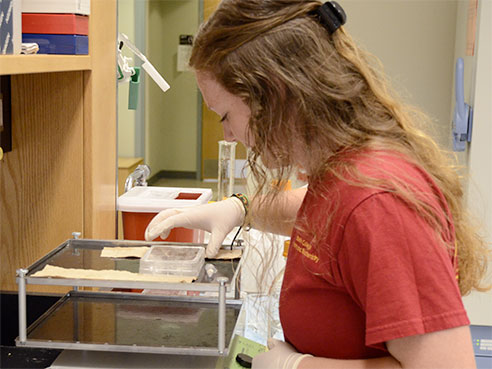 Krista Hoevemeyer, class of 2013, at a lab bench. UAB's SPIN program fosters career development for underrepresented minority college students and/or students from non-research-intensive universities.The University of Alabama at Birmingham Summer Program in Neuroscience, a program designed to promote careers in science to deserving undergraduate college students, has regained funding from the National Science Foundation. The new grant, $120,000 per year for three years, will allow for significant expansion of the program, which aims to foster career development and provide research training for underrepresented minority students and/or students from non-research-intensive universities.
Krista Hoevemeyer, class of 2013, at a lab bench. UAB's SPIN program fosters career development for underrepresented minority college students and/or students from non-research-intensive universities.The University of Alabama at Birmingham Summer Program in Neuroscience, a program designed to promote careers in science to deserving undergraduate college students, has regained funding from the National Science Foundation. The new grant, $120,000 per year for three years, will allow for significant expansion of the program, which aims to foster career development and provide research training for underrepresented minority students and/or students from non-research-intensive universities.“The SPIN program focuses on students with demonstrated scientific aptitude who have interest in pursuing a career in scientific research but have not been exposed to that environment,” said Gwendalyn King, Ph.D., assistant professor in the Department of Neurobiology and the SPIN program director. “SPIN is a 10-week research-intensive program in which students are mentored in UAB neuroscience labs to get a firsthand look at whether research is a good career option for them.”
The program enrolls 10 students each summer, usually juniors and seniors, who get hands-on experience in a laboratory, as well as career counseling. Students are paired with a UAB neuroscience faculty member and are also mentored by senior graduate students in the lab.
“The program is a real opportunity for learning what a career in science is all about,” said Lucas Pozzo-Miller, Ph.D., professor of neurobiology and SPIN co-director. “They don’t sit and watch — they are actively involved in the lab’s work. The goal of the program is that students accomplish enough to qualify for co-author status on research papers that originate in the lab.”
SPIN was originally funded by NSF for three years beginning in 2005. Following a loss of external funding in 2008, the program continued on a reduced scale through generous contributions from UAB internal organizations, including the Department of Neurobiology, the Comprehensive Neuroscience Center, the Civitan International Research Center and the Office of the Provost.
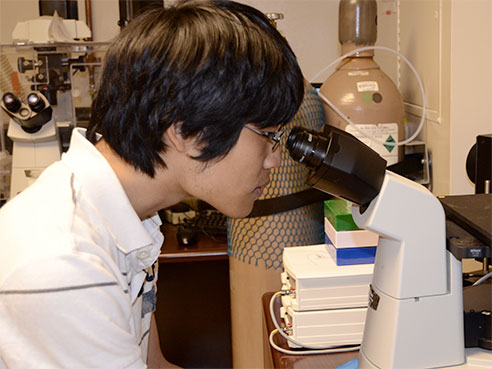 SPIN participants such as Jinwoo Hur, class of 2013, spend ten weeks in UAB neuroscience research labs.The reinstatement of NSF funding will allow the program to expand the number of students enrolled, provide stipends and help cover the cost of housing and meals. Since inception in 2005, SPIN has trained 106 undergraduates hailing from 29 states and two foreign countries.
SPIN participants such as Jinwoo Hur, class of 2013, spend ten weeks in UAB neuroscience research labs.The reinstatement of NSF funding will allow the program to expand the number of students enrolled, provide stipends and help cover the cost of housing and meals. Since inception in 2005, SPIN has trained 106 undergraduates hailing from 29 states and two foreign countries.Several former participants are now graduate students at UAB.
“I went to a small, liberal arts university in Minnesota for my undergraduate degree where there was little opportunity for doing research,” said Angie Nietz, now a fifth-year graduate student in the lab of Jacques Wadiche, Ph.D., associate professor of neurobiology. “The program gave me one of my only experiences of what it is like to do research outside of a classroom setting before entering graduate school. The research experience and excellent mentorship I received prepared me for applying to and being successful in graduate school.”
Nancy Gallus did her undergraduate work in molecular medicine at the University of Tübingen, Germany, before attending the UAB Spin program. She is now a graduate student in the laboratory of Jeremy Day, Ph.D., assistant professor of neurobiology.
“SPIN was very important for me, as it was one of my first real research experiences,” she said. “It also helped me decide where I wanted to go for graduate school and how to apply.”
Shelly Nason, now a second-year graduate student in the lab of Kirk Habegger, Ph.D., assistant professor, Department of Medicine, says her Michigan liberal arts college did not offer opportunities for neuroscience research.
“SPIN was most beneficial to me in professional development, beyond the benefits of understanding what it meant to participate in actual research,” she said. “I entered the program feeling less than confident in my ability to get into graduate school, and I left with the tools and confidence that helped me receive multiple acceptance letters. I highlight the SPIN program as the best opportunity in my undergraduate studies that propelled me forward in my career as a scientist.”
Pozzo-Miller says the program has benefit even for those attendees who ultimately decide against a career in science.
“These are people who will have a voice in the future of science,” he said. “They are voters, decision-makers and potential leaders of our country, and it is incumbent on us to teach them critical thinking skills, to help them understand the importance of scientific thought, and to understand and believe in the value of science.”
“Diversity in science is extremely important, as it is in all fields,” King said. “We need investigators with different backgrounds and different experiences. This program, we hope, will foster and instill a love of science in these students.”
The deadline for applying for a position in the 2017 SPIN program in March 1. The program runs from June 5 to Aug. 11.
Outstanding Research Scientist
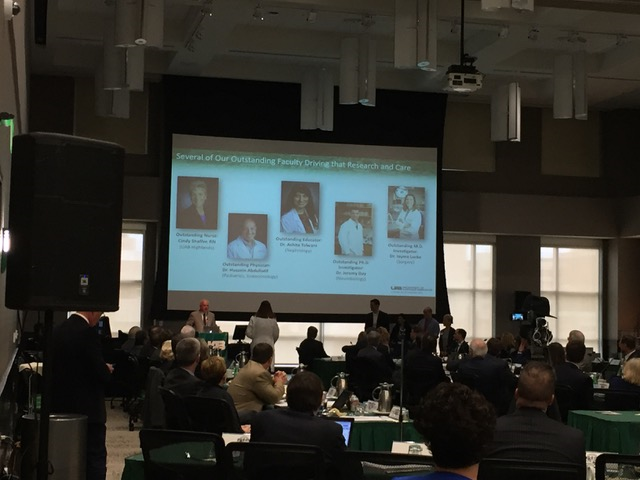
Wadiches Publish Brain Plasticity.....
It appears that new cells compete to ‘win’ synapse connections away from old cells, which promotes network plasticity.
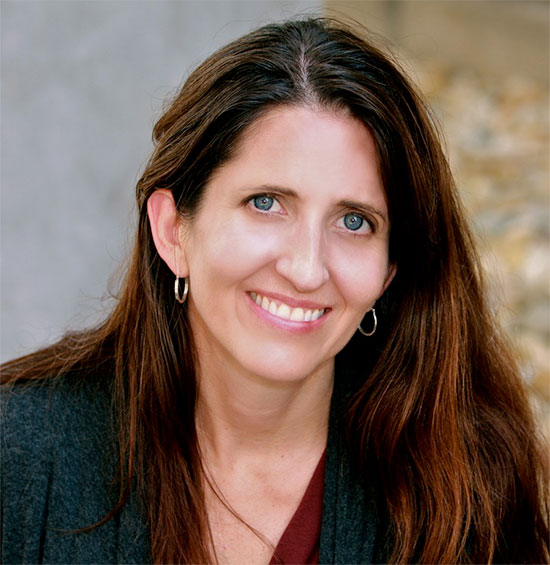 Linda Overstreet-Wadiche, Ph.D.
Linda Overstreet-Wadiche, Ph.D.
One goal in neurobiology is to understand how the flow of electrical signals through brain circuits gives rise to perception, action, thought, learning and memories.
Linda Overstreet-Wadiche, Ph.D., and Jacques Wadiche, Ph.D., both associate professors in the University of Alabama at Birmingham Department of Neurobiology, have published their latest contribution in this effort, focused on a part of the brain that helps form memories — the dentate gyrus of the hippocampus.
The dentate gyrus is one of just two areas in the brain where new neurons are continuously formed in adults. When a new granule cell neuron is made in the dentate gyrus, it needs to get ‘wired in,’ by forming synapses, or connections, in order to contribute to circuit function. Dentate granule cells are part of a circuit that receive electrical signals from the entorhinal cortex, a cortical brain region that processes sensory and spatial input from other areas of the brain. By combining this sensory and spatial information, the dentate gyrus can generate a unique memory of an experience.
Overstreet-Wadiche and UAB colleagues posed a basic question: Since the number of neurons in the dentate gyrus increases by neurogenesis while the number of neurons in the cortex remains the same, does the brain create additional synapses from the cortical neurons to the new granule cells, or do some cortical neurons transfer their connections from mature granule cells to the new granule cells?
Their answer, garnered through a series of electrophysiology, dendritic spine density and immunohistochemistry experiments with mice that were genetically altered to produce either more new neurons or kill off newborn neurons, supports the second model — some of the cortical neurons transfer their connections from mature granule cells to the new granule cells.
This opens the door to look at how this redistribution of synapses between the old and new neurons helps the dentate gyrus function. And it opens up tantalizing questions. Does this redistribution disrupt existing memories? How does this redistribution relate to the beneficial effects of exercise, which is a natural way to increase neurogenesis?
“Over the last 10 years there has been evidence supporting a redistribution of synapses between old and new neurons, possibly by a competitive process that the new cells tend to ‘win,’” Overstreet-Wadiche said. “Our findings are important because they directly demonstrate that, in order for new cells to win connections, the old cells lose connections. So, the process of adult neurogenesis not only adds new cells to the network, it promotes plasticity of the existing network.”
“It will be interesting to explore how neurogenesis-induced plasticity contributes to the function of this brain region,” she continued. “Neurogenesis is typically associated with improved acquisition of new information, but some studies have also suggested that neurogenesis promotes ‘forgetting’ of existing memories.”
The researchers also unexpectedly found that the Bax gene, known for its role in apoptosis, appears to also play a role in synaptic pruning in the dentate gyrus.
| “There is mounting evidence that the cellular machinery that controls cell death also controls the strength and number of synaptic connections” —Linda Overstreet-Wadiche |
“There is mounting evidence that the cellular machinery that controls cell death also controls the strength and number of synaptic connections,” Overstreet-Wadiche said. “The appropriate balance of synapses strengthening and weakening, collectively termed synaptic plasticity, is critical for appropriate brain function. Hence, understanding how synaptic pruning occurs may shed light on neurodevelopmental disorders and on neurodegenerative diseases in which a synaptic pruning gone awry may contribute to pathological synapse loss.”
All of the work was performed in the Department of Neurobiology at UAB. In addition to Overstreet-Wadiche and Wadiche, co-authors of the paper, “Adult born neurons modify excitatory synaptic transmission to existing neurons,” published in eLife, are Elena W. Adlaf, Ryan J. Vaden, Anastasia J. Niver, Allison F. Manuel, Vincent C. Onyilo, Matheus T. Araujo, Cristina V. Dieni, Hai T. Vo and Gwendalyn D. King.
Much of the data came from the doctoral thesis research of Adlaf, a former UAB Neuroscience graduate student who is now a postdoctoral fellow at Duke University.
Funding for this research came from Civitan International Emerging Scholars awards, and National Institutes of Health awards or grants NS098553, NS064025, NS065920 and NS047466.
School of Medicine Annual Report
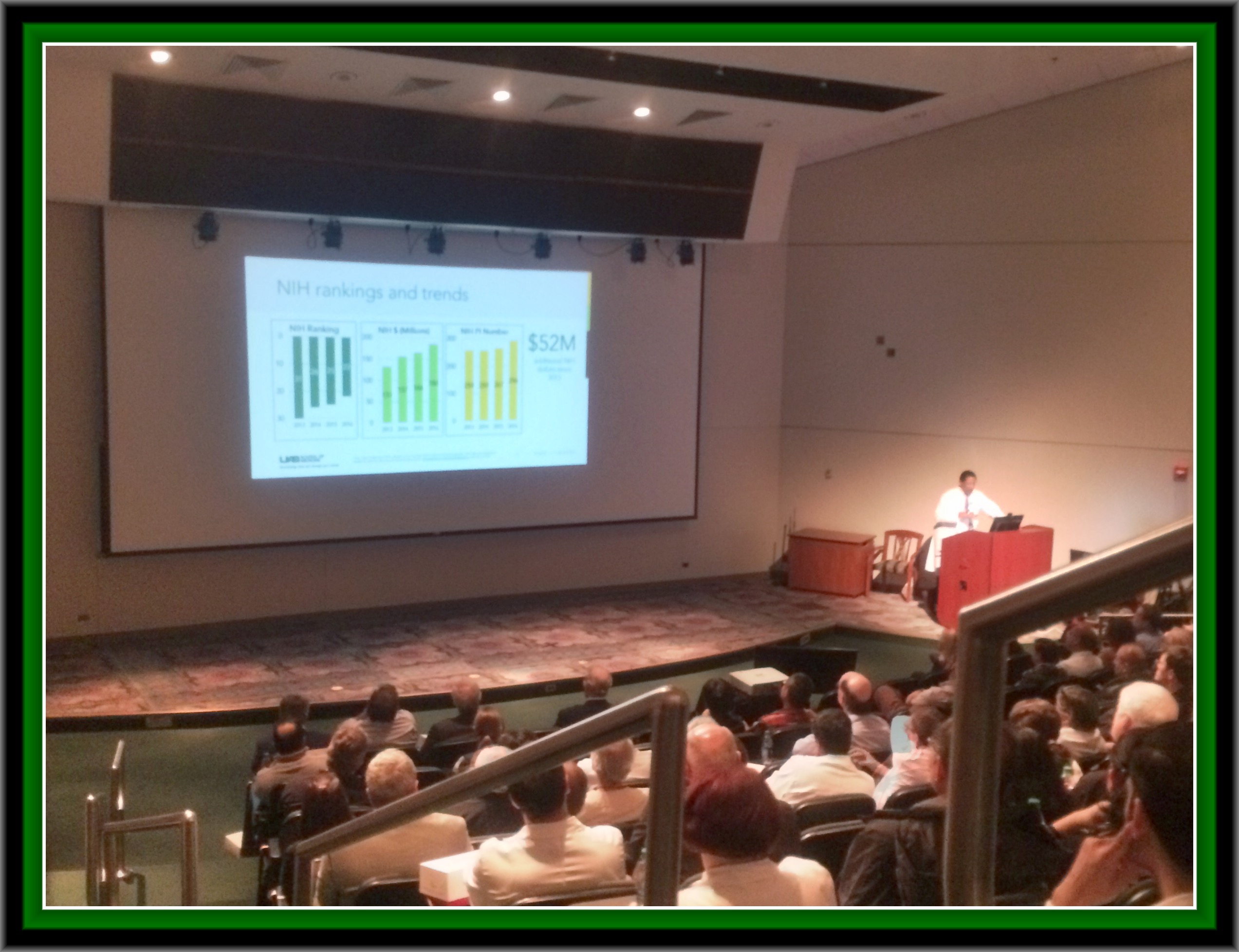
Dobrunz published in Journal of Neuroscience
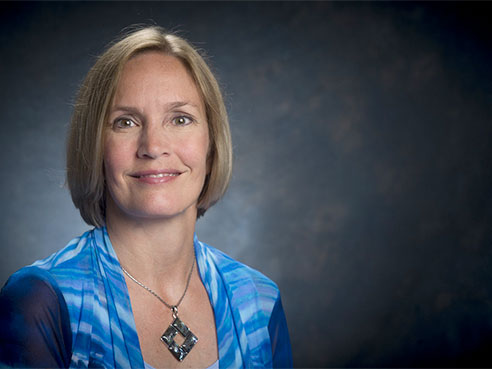 UAB neurobiologist Lynn Dobrunz, Ph.D.University of Alabama at Birmingham neurobiologist Lynn Dobrunz, Ph.D., has discovered a novel mechanism for how stress-induced anxiety — the type of experience that can produce post-traumatic stress disorder, or PTSD — affects circuit function in the hippocampus, the area of the brain where aversive memories are formed.
UAB neurobiologist Lynn Dobrunz, Ph.D.University of Alabama at Birmingham neurobiologist Lynn Dobrunz, Ph.D., has discovered a novel mechanism for how stress-induced anxiety — the type of experience that can produce post-traumatic stress disorder, or PTSD — affects circuit function in the hippocampus, the area of the brain where aversive memories are formed. These studies by Dobrunz and colleagues fill an important gap in knowledge between the molecular, circuit and behavioral effects of the brain-signaling molecule called neuropeptide Y. Their findings, published in the Journal of Neuroscience, could pave the way for new therapeutic targets to increase neuropeptide Y release in the appropriate brain pathway for patients with anxiety disorders.
Increased levels of neuropeptide Y are well-known to produce anxiety-relieving effects. In contrast, the levels of neuropeptide Y are reduced in people with PTSD and other anxiety disorders. Until now, the mechanism of how changing levels of neuropeptide Y alters circuit function to reduce or increase anxiety behavior has not been known. Besides describing a mechanism for that, the UAB researchers also show that the stress of exposing mice to a predator scent — a compound found in the feces of foxes — prevents the release of neuropeptide Y, potentially enhancing anxiety.
PTSD is a public health challenge. It is marked by reactions to trauma or a life-threatening event that do not go away or even grow worse — reactions such as jumpiness, difficulty sleeping or upsetting memories. About 3.5 percent of the U.S. population has PTSD in a given year, and the rate for women is nearly three times higher than that for men, according to the U.S. Department of Veterans Affairs. The estimated prevalence of PTSD among Gulf War veterans and veterans of Iraq and Afghanistan exceeds 10 percent.
Major findings
In their research, Dobrunz and colleagues focused on the CA1 area of the hippocampus. CA1 is involved in learning and memory, and distinct sets of neurons there are able to release neuropeptide Y.Two neural pathways activate CA1 — the Schaffer collateral, or SC, pathway and the temporoammonic, or TA, pathway. While both pathways are involved in fear learning, the TA pathway has been shown to be particularly sensitive to stress. Using a novel, physiologically based assay, the researchers were able to send a train of electrical pulses through these pathways to stimulate the release of endogenous neuropeptide Y from three subtypes of neurons in CA1.
| PTSD is a public health challenge. It is marked by reactions to trauma or a life-threatening event that do not go away or even grow worse — reactions such as jumpiness, difficulty sleeping or upsetting memories. About 3.5 percent of the U.S. population has PTSD in a given year, and the rate for women is nearly three times higher than that for men. |
Importantly, the researchers found that stressing mice with predator scent — a mouse model of PTSD — impaired the release of endogenous neuropeptide Y in the TA pathway and altered the function of the TA synapses. This impairment of neuropeptide Y release, Dobrunz and colleagues say, contributes to circuit dysfunction in the CA1 area of the hippocampus in response to stress.
From this study and what others know about the hippocampus, the UAB results suggest the following train of events: 1) The stress of smelling a predator scent impairs neuropeptide Y release. 2) This reduction in neuropeptide Y release enhances short-term plasticity of TA synapses. 3) The enhanced plasticity, in turn, boosts the strength of that pathway to drive more spiking of CA1 nerve cells. 4) Increased spiking alters the hippocampal output, a changed output that may increase the consolidation of fear learning.
“Our study,” the authors wrote, “is the first demonstration of the impact of endogenously released neuropeptide Y on SC and TA short-term plasticity in response to stimulation with a physiologically derived spike train. While no in vitro experiment completely duplicates in vivo conditions, these experiments bring us one step closer to the physiological situation and advance our understanding of how temporally complex activity regulates neuropeptide Y release from neuropeptide Y-positive interneurons.”
Furthermore, Dobrunz says, her novel assay could also be used to detect effects of endogenous neuropeptide Y release in other neurological and neuropsychiatric disorders where neuropeptide Y is implicated. These include epilepsy, depression and schizophrenia.
Besides Dobrunz, who is an associate professor of neurobiology, the authors of “Endogenously released neuropeptide Y suppresses hippocampal short-term facilitation and is impaired by stress-induced anxiety” are Qin Li and Aundrea F. Bartley, UAB Department of Neurobiology, Civitan International Research Center and the Evelyn F. McKnight Brain Institute.
This research was supported by National Institutes of Health Grant MH-108342 and a UAB Center for Clinical and Translational Sciences pilot award.
Save-the-Date Neurodevelopment Symposium
